Related Research Articles
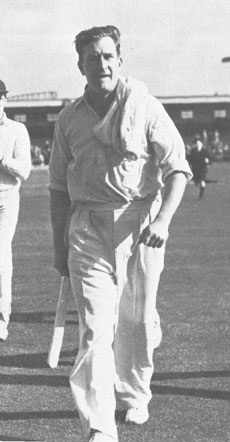
James Charles Laker was an English professional cricketer who played for Surrey County Cricket Club from 1946 to 1959 and represented England in 46 Test matches. He was born in Shipley, West Riding of Yorkshire, and died in Wimbledon, London.
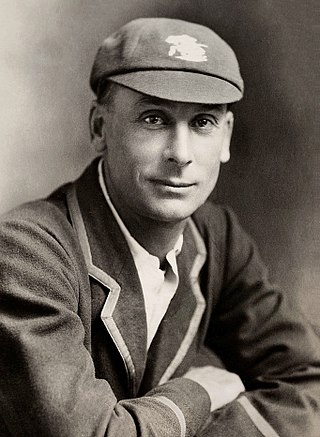
Sir John Berry Hobbs was an English professional cricketer who played for Surrey from 1905 to 1934 and for England in 61 Test matches between 1908 and 1930. Known as "The Master", he is widely regarded as one of the greatest batsmen in the history of cricket. He is the leading run-scorer and century-maker in first-class cricket, with 61,760 runs and 199 centuries. A right-handed batsman and an occasional right-arm medium pace bowler, Hobbs also excelled as a fielder, particularly in the position of cover point. Hobbs was named as one of the five Wisden Cricketers of the Century alongside Sir Donald Bradman, Sir Garfield Sobers, Shane Warne, and Sir Viv Richards.
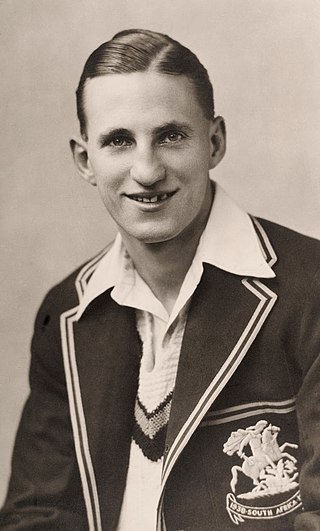
Sir Leonard Hutton was an English cricketer. He played as an opening batsman for Yorkshire County Cricket Club from 1934 to 1955 and for England in 79 Test matches between 1937 and 1955. Wisden Cricketers' Almanack described him as "one of the greatest batsmen in the history of cricket". He set a record in 1938 for the highest individual innings in a Test match in only his sixth Test appearance, scoring 364 runs against Australia, a milestone that stood for nearly 20 years. Following the Second World War, he was the mainstay of England's batting. In 1952, he became the first professional cricketer of the 20th century to captain England in Tests; under his captaincy England won the Ashes the following year for the first time in 19 years.
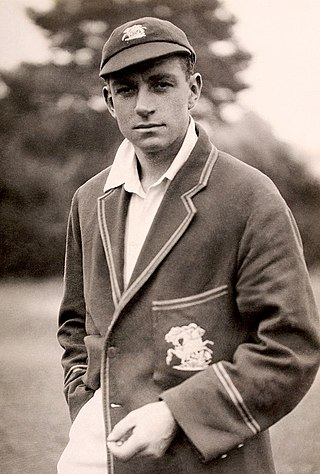
Walter Reginald Hammond was an English first-class cricketer who played for Gloucestershire in a career that lasted from 1920 to 1951. Beginning as a professional, he later became an amateur and was appointed captain of England. Primarily a middle-order batsman, Wisden Cricketers' Almanack described him in his obituary as one of the four best batsmen in the history of cricket. He was considered to be the best English batsman of the 1930s by commentators and those with whom he played; they also said that he was one of the best slip fielders ever. Hammond was an effective fast-medium pace bowler and contemporaries believed that if he had been less reluctant to bowl, he could have achieved even more with the ball than he did.
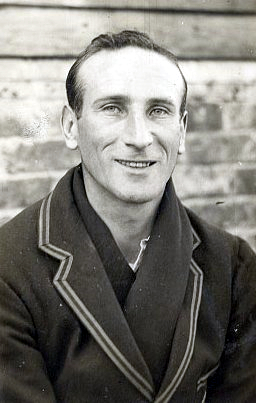
Douglas Robert Jardine was an English cricketer who played 22 Test matches for England, captaining the side in 15 of those matches between 1931 and 1934. A right-handed batsman, he is best known for captaining the English team during their successful 1932–33 Ashes tour of Australia. During that series, England employed "Bodyline" tactics against the Australian batsmen, headed by Donald Bradman, wherein bowlers pitched the ball short on the line of leg stump to rise towards the bodies of the batsmen in a manner that some contemporary players and critics viewed as intimidatory and physically dangerous. As captain, Jardine was the person responsible for the implementation of Bodyline.
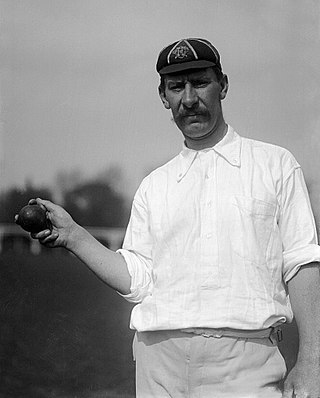
Albert Edwin Trott was a Test cricketer for both Australia and England. He was named as one of the Wisden Cricketers of the Year in 1899. He is believed to be the only batsman to have struck a ball over the top of the Lord's Pavilion. He is also one of only two players to take two hat-tricks in the same first-class innings, the other being Joginder Rao. Despite his notability, having played in 375 first-class matches including 5 Tests, he was almost penniless when he killed himself at the age of 41.
Donald Bryce Carr OBE was an English cricketer who played for Derbyshire from 1946 to 1967, for Oxford University from 1948 to 1951, and twice for England in 1951/52. He captained Derbyshire between 1955 and 1962 and scored over 10,000 runs for the county.
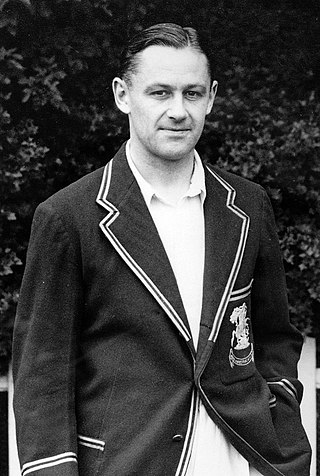
Sir George Oswald Browning "Gubby" Allen CBE was a cricketer who captained England in eleven Test matches. In first-class matches, he played for Middlesex and Cambridge University. A fast bowler and hard-hitting lower-order batsman, Allen later became an influential cricket administrator who held key positions in the Marylebone Cricket Club (MCC), which effectively ruled English cricket at the time; he also served as chairman of the England selectors.

Norman Walter Dransfield Yardley was an English cricketer who played for Cambridge University, Yorkshire County Cricket Club and England, as a right-handed batsman and occasional bowler. An amateur, he captained Yorkshire from 1948 to 1955 and England on fourteen occasions between 1947 and 1950, winning four Tests, losing seven and drawing three. Yardley was named Wisden Cricketer of the Year in 1948, and in his obituary in Wisden Cricketers' Almanack he was described as Yorkshire's finest amateur since Stanley Jackson.

Wilfred Rhodes was an English professional cricketer who played 58 Test matches for England between 1899 and 1930. In Tests, Rhodes took 127 wickets and scored 2,325 runs, becoming the first Englishman to complete the double of 1,000 runs and 100 wickets in Test matches. He holds the world records both for the most appearances made in first-class cricket, and for the most wickets taken (4,204). He completed the double of 1,000 runs and 100 wickets in an English cricket season a record 16 times. Rhodes played for Yorkshire and England into his fifties, and in his final Test in 1930 was, at 52 years and 165 days, the oldest player who has appeared in a Test match.

Percy George Herbert Fender was an English cricketer who played 13 Tests for his country and was captain of Surrey between 1921 and 1931. An all-rounder, he was a middle-order batsman who bowled mainly leg spin, and completed the cricketer's double seven times. Noted as a belligerent batsman, in 1920 he hit the fastest recorded first-class century, reaching three figures in only 35 minutes, which remains a record as of 2021. On the basis of his Surrey captaincy, contemporaries judged him the best captain in England.
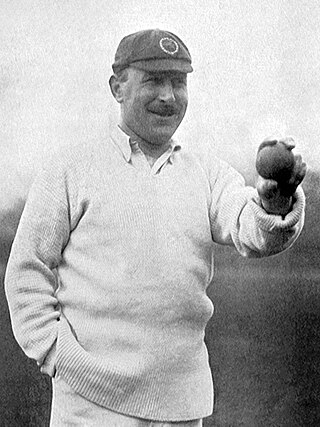
George Herbert Hirst was a professional English cricketer who played first-class cricket for Yorkshire County Cricket Club between 1891 and 1921, with a further appearance in 1929. One of the best all-rounders of his time, Hirst was a left arm medium-fast bowler and right-handed batsman. He played in 24 Test matches for England between 1897 and 1909, touring Australia twice. He completed the double of 1,000 runs and 100 wickets in an English cricket season 14 times, the second most of any cricketer after his contemporary and team-mate Wilfred Rhodes. One of the Wisden Cricketers of the Year for 1901, Hirst scored 36,356 runs and took 2,742 wickets in first-class cricket. In Tests, he made 790 runs and captured 59 wickets.
This is a bibliography of literary and historical works about cricket. The list is sorted by author's name. It is inevitably highly selective. The 1984 edition of E. W. Padwick's A Bibliography of Cricket had more than 10,000 entries.

Maurice Leyland was an English international cricketer who played 41 Test matches between 1928 and 1938. In first-class cricket, he represented Yorkshire County Cricket Club between 1920 and 1946, scoring over 1,000 runs in 17 consecutive seasons. A left-handed middle-order batsman and occasional left-arm spinner, Leyland was a Wisden Cricketer of the Year in 1929.

Ernest William "Jim" Swanton was an English journalist and author, chiefly known for being a cricket writer and commentator under his initials, E. W. Swanton. He worked as a sports journalist for The Daily Telegraph and as a broadcaster for BBC Radio for 30 years. He was a regular commentator on Test Match Special, easily recognised by his distinctive "fruity" voice. After "retiring" in the 1970s, he continued to write occasional articles and columns until his death in 2000.

George Gibson Macaulay was a professional English cricketer who played first-class cricket for Yorkshire County Cricket Club between 1920 and 1935. He played in eight Test matches for England from 1923 to 1933, achieving the rare feat of taking a wicket with his first ball in Test cricket. One of the five Wisden Cricketers of the Year in 1924, he took 1,838 first-class wickets at an average of 17.64 including four hat-tricks.
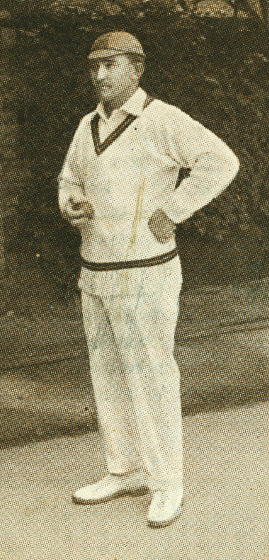
Albert Edward Ernest Vogler was a South African cricketer. A leading all-rounder skilled both at batting and bowling, Vogler played cricket in South Africa prior to becoming eligible to play for Middlesex County Cricket Club in England after serving on the ground staff of the Marylebone Cricket Club at Lord's. He rose to prominence during the 1906 home Test series and then in England the following year: he was described during the latter as the best bowler in the world by Tip Foster, and named a Wisden Cricketer of the Year.
William Mycroft was an English cricketer who played first-class cricket for Derbyshire and MCC between 1873 and 1886. He was a left-arm fast bowler with a great deal of spin and a dangerous yorker that was often believed to be unfair – which may explain why he was not considered for the earliest Test Matches despite being in his prime. He took 863 first-class wickets at an average of 12.09 with 87 five-wicket innings and 28 ten-wicket matches in his career. His first ten-wicket match in 1875 against Nottinghamshire became the first of six in only nine games that season. He holds the Derbyshire record for most wickets in a single match, with figures of 17–103 against Hampshire at the Antelope Ground, Southampton in July 1876. This is one of only two times a player has taken seventeen wickets in a match and finished on the losing side – the other, by Walter Mead in 1895 was also against Hampshire. Mycroft had no pretensions as a right-handed tail end batsman: he scored only 791 first-class runs at an average of 5.34 and prior to Alf Hall and Father Marriott remained the last significant cricketer who took more wickets than he scored runs.
Francis Joseph Shacklock was an English cricketer who played first-class cricket for Nottinghamshire in 1883 and between 1886 and 1893, for Derbyshire in 1884 and 1885, for MCC between 1889 and 1893, and for Otago in New Zealand from 1903 to 1905. Shacklock may have been the inspiration for the first name of Arthur Conan Doyle's character Sherlock Holmes.
George Herbert Chesterton MBE was an English cricketer who played first-class cricket between 1949 and 1966. The bulk of his appearances were for Worcestershire, whom he represented between 1950 and 1957. He was capped by the county in 1950. Very much a specialist bowler, he never reached 50 in over 100 first-class innings.
References
- 1 2 3 "Sandford, Christopher 1956–". Encyclopedia.com. Retrieved 10 January 2021.
- ↑ Christopher Sandford, "Never See His Kind Again", Chronicles Magazine , April 2013, pp. 38–41.
- ↑ "Christopher Sandford". Russian Life. Retrieved 10 January 2021.
- ↑ 'Cambridge University tripos results in philosophy and history', Times, 30 June 1977, p. 18. Retrieved 9 August 2021.
- ↑ "Christopher Sandford". Macmillan. Retrieved 10 January 2021.
- ↑ "Christopher Sandford". Duckworth. Retrieved 10 January 2021.
- ↑ "The Cricket Society/ MCC Book of the Year". The Cricket Society. Archived from the original on 15 April 2019. Retrieved 20 April 2021.
- ↑ Wisden 2020, p. 119.